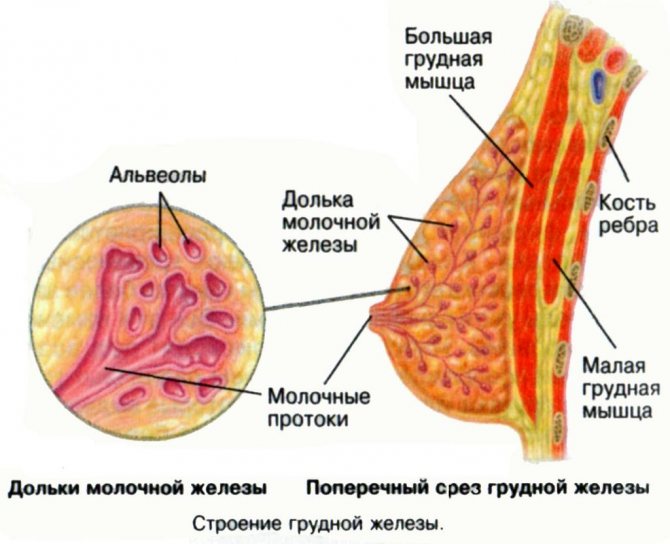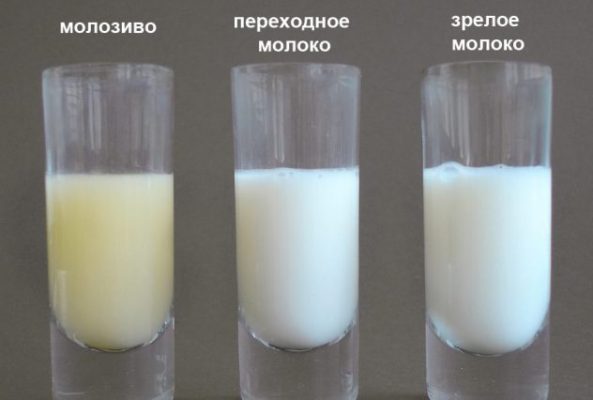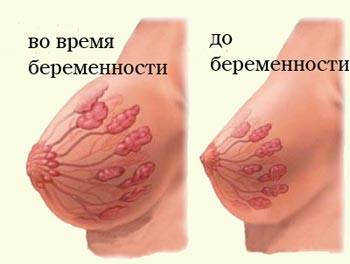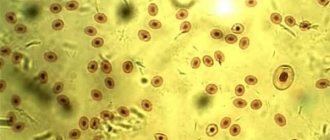Pregnancy and colostrum
At what stage of pregnancy does colostrum begin to be released?
What color and consistency should it be? How does the woman feel? How to perform hygienic breast care? These are not all the questions that pregnant women ask. You can get answers to them by reading the article. In the process of bearing a child, most women begin to be sensitive to their well-being. They are acutely aware of all the changes occurring in the body. Many pregnant women are frightened by the appearance of discharge from the breast. Gynecologists reassure impressionable women, saying that everything is fine, the breasts are just preparing to feed the baby and producing colostrum.
Composition and purpose
Colostrum is a viscous, sweetish liquid with a characteristic odor produced in the female mammary glands during pregnancy and several days after delivery. Color – from yellow to translucent. It is the prototype of breast milk and, in comparison with it, contains less water, fat and sugar, but more protein.
The secretion that precedes breast milk has a composition rich in useful elements:
- proteins – albumin and globulin;
- water;
- lacto- and bifidobacteria;
- vitamins A, B, C, E, K and PP;
- fats;
- minerals;
- lactose;
- hormones;
- food enzymes;
- retinol;
- tocopherol;
- immunoglobulin;
- leukocytes.
Due to its rich composition, the secret brings invaluable benefits to the baby. It is several times higher in calories than breast milk and promotes rapid weight gain in the newborn. Due to the lesser presence of water, it does not overload the baby’s urinary system.
The bacteria present in colostrum prepare the baby's fragile digestive system to digest heavier foods. The milk prototype normalizes the functioning of the newborn’s intestines and cleanses it of meconium (primary feces). The components of colostrum contribute to the formation of the child’s immunity, prevent postpartum jaundice and trigger all vital processes of the child’s body.
When is colostrum formed during pregnancy?
After fertilization, the female body undergoes many changes. This is how he adapts to the new state. The breast prepares for lactation throughout the entire gestation period. At this time, the concentration of hormones in the pregnant woman’s body changes. The production of prolactin, the hormone responsible for the lactation process, increases. At the same time, an increase in the milk ducts and lobules of the gland occurs. The work of the latter is activated, which leads to the process of colostrum formation.
In primiparous women
In women carrying a child for the first time, preparation for the production of breast milk may begin not from the moment of conception, but somewhat later. The body is experiencing pregnancy for the first time, and it takes time to rebuild. However, having “experience” in this matter is not a decisive factor. Lactation (including colostrum production) is influenced by many factors.
In women who give birth repeatedly
Women who have given birth before observe the appearance of the milk prototype at an earlier stage compared to first-time mothers. Their body knows what to prepare for and how to behave. It takes him much less time to adapt to the new situation. Despite this, not all pregnant women experience an early rush of nutrient secretions.
Signs of colostrum during pregnancy
Before the appearance of colostrum, you may experience discomfort in the breasts: itching and tingling. This is explained by the movement of secretions through the ducts. The breasts increase in size, become heavy and firm to the touch.
What month should I wait?
The production of colostrum begins to occur from the earliest stages of gestation.
However, it can only be noticed at a later stage. In 20% of cases, pregnant women notice the appearance of fluid in the early stages of gestation. The remaining 80% of women do not see or feel the appearance of a secretion until the 12th week. In the early stages, the amount of secretion is still too small and is not released from the nipples of the pregnant woman.
The second trimester (13-30 weeks of gestation) is marked by increased production of prototype breast milk. Most pregnant women notice the appearance of sticky liquid on their underwear. Colostrum may not be released every day in the second trimester. Doesn't depend on its appearance or time of day.
Late pregnancy (from 31 weeks until delivery) is characterized by abundant production of nutritious secretions. By this time, the color of the colostrum loses its saturation, and its quantity may remain virtually unchanged.
The moment when colostrum appears varies from person to person. It is impossible to say exactly when to expect it. Strengthening its production is influenced by:
- emotional shocks (positive or negative);
- hot shower or bath;
- high temperatures and high humidity in the room;
- hot drink;
- sexual contact;
- breast massage;
- genetic predisposition.
What color is the discharge from the nipples?
The acceptable color of the secretion is yellow or cream shades; the appearance of a translucent liquid is possible.
Typically, at the beginning of the production process, yellow or cream-colored colostrum is released. During gestation, its color changes and in later stages the secreted fluid may become transparent.
Does your chest hurt?

It manifests itself with itching and tingling. This is normal, as the woman feels the fluid moving through the milk ducts. If pain occurs in the chest area, especially associated with a feeling of heaviness in the lower back, you must inform your doctor. This way the body can signal the risk of miscarriage or premature birth.
The appearance of chest pain can signal the presence of inflammation in the body, which can trigger the occurrence of mastitis and congestion in the chest. In such conditions, breast milk poses a danger to the baby. To prevent such situations, you need to promptly inform your gynecologist about changes in your health.
Where does colostrum accumulate?
The main purpose of the female breast is to feed offspring. There are cavities inside it designed to store milk during lactation. When the concentration of prolactin in the body increases during pregnancy, the process of producing breast milk starts. At first, it is immature and is excreted in the form of colostrum. During pregnancy, its amount is small and it accumulates in the milk ducts. As the volume increases, colostrum begins to flow into the breast cavities and, when they are filled, spontaneously flows out through the nipples.
How much colostrum should you have during pregnancy?
The production of colostrum is an individual feature of each organism.
It can be released in the amount of 1 drop or 2.5 ml at a time. In this range, the volume of fluid is considered normal. If there is a significant increase in the amount of breast secretion, you should inform your doctor. When the volume of colostrum produced suddenly increases in the blood of a pregnant woman, the concentration of the hormone oxytocin increases. This hormone in large quantities can provoke an increase in uterine tone, which can lead to spontaneous abortion or premature birth.
The volume of colostrum cannot be used to judge the intensity of lactation and how much breast milk a nursing woman will produce.
If there are no signs of colostrum formation during pregnancy
The process of colostrum formation is individual for each woman. For some it begins in the early stages, for others - in the 2nd or 3rd trimester. There are women whose colostrum comes only after childbirth. Moreover, this can happen either a few hours or 1-2 days after delivery.
The absence of colostrum during pregnancy is not considered a pathology or deviation from the norm.
Why is colostrum released during pregnancy?
If colostrum is released from your breasts while carrying a baby, this is absolutely normal, but if it is not there, then there is no need to worry either.

What is colostrum during pregnancy?
Its appearance is a sign that the expectant mother’s body is preparing for the birth of a child and is trying to provide the baby with healthy nutrition in advance.
At what stage does colostrum appear during pregnancy? The timing of appearance is very individual, most often milk discharge can be seen in the second half of the gestational period, in some women it appears only a few weeks or days before the birth of the baby, colostrum is often observed in the early stages of pregnancy.
Characteristics of colostrum at different stages
- In the first trimester. Almost immediately after conception, the mammary glands begin to actively prepare for breastfeeding - the lobules and diameter of the ducts increase. At this stage, colostrum is usually released in small quantities, you may not even notice it. But in some cases, it is the appearance of a large amount of unripe milk that becomes the first manifestation of pregnancy.
- In the second trimester , colostrum is synthesized more actively, and sticky spots can be seen on the underwear. The amount of milk discharge does not depend on the time of day and nutrition; they do not necessarily appear every day.
- In the third trimester , the amount of colostrum increases and its consistency changes. After birth, it is secreted for about a week, after which it is replaced with full breast milk.
When colostrum is released, discomfort in the mammary glands often occurs - tingling, itching, this is due to the fact that the pectoral muscles tense to push the fluid to the nipple. Since unripe milk is quite thick, the discomfort is quite noticeable.

If there is no colostrum, then this is not considered a pathology, there is no need to stress yourself out and think that you will not have milk after childbirth. The release of colostrum depends on various physiological reasons, so it is quite normal if the first drops begin to be released immediately after the birth of the baby.
If your glands produce clear fluid instead of yellow colostrum
Clear colostrum is not a deviation from the norm.
The color may be different for each woman. Usually at the beginning of its appearance it is yellowish or cream-colored. Towards the end of pregnancy, its shade becomes less saturated, and sometimes disappears altogether. In such situations, the allocated secret becomes transparent. Some women produce clear colostrum from the very beginning of its production. To completely reassure the pregnant woman, it is recommended to inform the doctor who is managing the pregnancy about this.
Colostrum with blood during pregnancy
A small amount of blood impurities is not a serious abnormality if it occurs in late pregnancy. If this happens constantly, and painful sensations appear, this is already an alarming sign. There is also always cause for concern if there is a lot of blood coming out.
More often, colostrum with blood is a sign of an inflammatory process. Its focus can be both in the mammary glands and in other internal organs. It is important to pay attention to the woman’s well-being, which in such cases deteriorates sharply.
Also, blood in colostrum can be a sign of breast tumors. Most often, it first flows from one mammary gland, and over time from the second. The formation can be either benign or malignant. The sooner the expectant mother consults a doctor, the sooner he will make a diagnosis and take action. Usually, if blood is a symptom of neoplasms, changes in the shape of the breast, the appearance of tubercles or depressions, and redness of the skin are also observed.

If there is bloody discharge from the nipples
The presence of a small amount of blood in colostrum is normal (especially in late pregnancy).
When preparing the body for childbirth, a woman's production of immature milk (colostrum) increases. The milk ducts stretch as the flow of secretions into the breast increases. This may be accompanied by microcracks in blood vessels. The result is the appearance of blood impurities in the colostrum.
If colostrum contains a large amount of blood, urgent medical consultation is required. This phenomenon may signal the onset of an inflammatory process in the body or the appearance of a tumor in the breast. In such situations, laboratory testing of colostrum is indicated for an accurate diagnosis.
The appearance of a large amount of blood in the colostrum, accompanied by pain in the lower abdomen or lumbar region, may indicate a threat of miscarriage.
Colostrum appears during pregnancy - what to do
If there is no threat of miscarriage, the appearance of colostrum should not bother you in any way.
If the discharge is very heavy, use special absorbent bra pads, they can be purchased at any pharmacy.

Rules for caring for the mammary glands when secreting colostrum:
- Change pads as often as possible, since a moist, warm environment combined with nutrient fluid is an excellent place for the proliferation of various pathogens.
- Be sure to wash your breasts with warm water and wipe with baby wipes.
- Use hypoallergenic breast moisturizers to help prevent stretch marks and cracked nipples in the future.
- Try to stick to proper nutrition - reduce the amount of food with fast carbohydrates, 4-5 weeks before giving birth, increase the amount of fat in the diet.
If colostrum is released from the breast, it is strictly forbidden to express it, it is forbidden to massage the mammary glands - any stimulation can negatively affect the course of pregnancy. Remember, with the active production of immature milk, the uterus begins to actively contract.
Stress, sexual intercourse, heat, hot showers, or consumption of hot drinks and food can increase the secretion of colostrum in pregnant women.
If you are already actively producing immature milk, try to protect yourself from provoking factors.
How much colostrum is released after childbirth?
Many women who have given birth to their first child are frightened when they notice how much colostrum they produce after childbirth. Often the volume of prototype milk released at one time is 1-3 drops. This is a normal amount of fluid, which will increase in proportion to the frequency of the baby's attachment to the breast. During the first 1-2 days, the normal volume of unripe milk is about 30 ml. This amount is quite enough for a newborn, because colostrum has greater nutritional value compared to full breast milk.
To increase the production of colostrum in the body, it is recommended to breastfeed your baby every 20 minutes. Nipple stimulation enhances lactation.
About colostrum after childbirth
When the baby is born, the colostrum becomes more transparent. Its chemical composition is preserved. It is released in the first three to seven days after birth. Then full-fledged milk begins to be released from the mammary glands. Before this, the secretion of the mammary glands performs the following useful functions:
- Saturation of the child's body with immune cells.
Since a baby’s own immunity is developed only from the age of six months, until this period his health is maintained by his mother’s breast milk, the precursor of which is colostrum. It produces cells that are involved in protecting the baby from harmful environmental microorganisms. - Colonization of the intestines with the necessary microflora.
We are talking about bifidobacteria and lactobacilli. This flora promotes the absorption of breast milk or adapted formulas. - Acceleration of meconium excretion.
This is the name of the original feces that fills the intestines of a newborn. After removing it from the body, the baby’s intestines are ready for the first mother’s milk to enter. - Binding of bilirubin from blood.
Sometimes it occurs in excessive quantities in newborns, which is manifested by jaundice. Colostrum promotes the absorption of bilirubin and its removal from the body. - Enriching the baby’s body with nutrients
that are needed from the first days of life. - Saturation of the newborn's blood with antioxidants,
helping to adapt to life outside the mother's womb. - Acceleration of the formation of intestinal epithelium.
As you can see, the functions of colostrum are multifaceted. That is why, when the baby is born, it is immediately applied to the mother’s breast.
Women during pregnancy should not worry about the fact that they are not producing colostrum. This may also be a variant of the physiological norm. After all, each organism is individual.
Colostrum before menstruation is not the most common phenomenon. But it is still possible, so it is worth considering the characteristic symptoms and possible causes.
Can women produce colostrum? It occurs only at certain stages of life. Such discharge indicates the readiness of the mammary glands for breastfeeding and is usually observed during pregnancy, especially in the third trimester and shortly before the birth of the child. Colostrum is produced in the first few days after birth: it contains special substances that contribute to the formation of the newborn’s immune system.
Nipple discharge is considered normal after lactation has ended and may continue for a year or longer. But if colostrum is released from the breast several years after the end of breastfeeding, or it appears in a woman who has never given birth, then this symptom should be a reason to consult a doctor.

When the milk arrives
The process of milk “ripening” occurs individually for each woman. Complete breast milk comes at different times. On average, this occurs 3-5 days after birth. The number of previous births plays an important role.
- in primiparous women, milk may come only on the 5th-6th day of the baby’s life;
- In mothers who have previously given birth, colostrum is replaced by milk 3-4 days after birth.
With each subsequent birth, milk comes in faster. This is explained by the fact that the body of a woman giving birth quickly adapts to the new state and knows how to behave. In any case, the lactation process is fully established no later than 1 week after the birth of the child.
Hygiene rules
As colostrum begins to secrete, the breasts require more careful care. The milk prototype creates favorable conditions for the growth of bacteria. In the absence of sufficient hygiene, the risk of infection in a woman’s body increases.
Basic rules of breast hygiene:
- Wash your breasts at least 2 times a day. It is not recommended to use soap for these purposes, as it dries the skin and can cause cracks in the nipples.
- Don't rub your breasts. You can lightly blot it with a soft towel.
- If there is excessive fluid secretion, use sanitary pads for the breasts and replace them regularly.
- Wear comfortable underwear that does not tighten the chest, made of natural fabric.
- To avoid cracking of the nipples, use special moisturizers.
- Reduce your intake of fats and carbohydrates, replacing them with protein foods. Eat enough fresh vegetables and fruits.
The release of colostrum during pregnancy is a natural, but not obligatory, condition. All women experience lactation differently. There is no exact date for its appearance. After unripe milk has begun to form, you need to monitor the nature of the discharge and follow the rules of hygiene.
Discharge from the mammary glands during pregnancy
Already from the first days after conception, changes in the mammary glands begin. The breast enlarges, becomes sensitive, and a venous network often appears on it.
Quite often, expectant mothers experience breast discharge during pregnancy. In most cases, this colostrum is yellow in color. Sometimes nipple discharge during pregnancy has a milky tint. Such signs are harbingers of milk.
Indeed, during the period when a woman is carrying a baby, there is an active increase in the volume of the mammary glands due to the proliferation of glandular tissue. prolactin acts on the mammary glands .
Most often, colostrum from the breasts during pregnancy begins to be released on the eve of the birth of the baby. But sometimes discharge from the mammary glands appears earlier during pregnancy - in the second trimester, at about 23 weeks of pregnancy.
Only after the birth of the child, after 2-3 days, colostrum replaces milk. But colostrum is a necessary substance for the baby, since it is very high in calories and contains a large amount of antibodies , which are very important for the newborn.
If discharge from the breast appears before the baby is born, it is important to strictly monitor hygiene and monitor the condition of the nipples. The chest should be washed with boiled water in the morning and evening, and then gently wiped dry. It is also recommended to do air baths for the nipples - this procedure prevents the appearance of cracks after childbirth .
Those who notice that the discharge stains their underwear should wear special pads. If the price of maternity pads for pregnant women seems high, you can use sterile cotton pads for these purposes, which are sold in pharmacies.
If a woman is concerned about certain features of this symptom, it is better for her to tell her gynecologist about it.
A pregnant woman should also consult a doctor in the following cases:
- with regular aching chest pain;
- with uneven enlargement of the mammary glands;
- if depressions or bumps appear on the chest;
- if bloody discharge appears from the chest.
It is important to wear comfortable underwear that will not restrict your chest.











